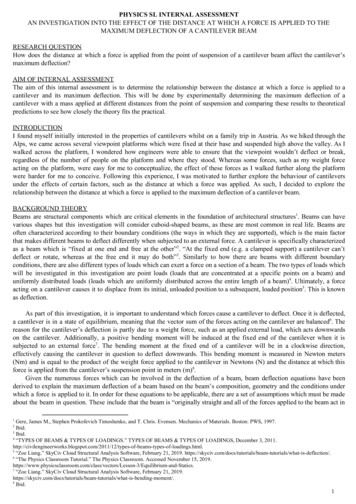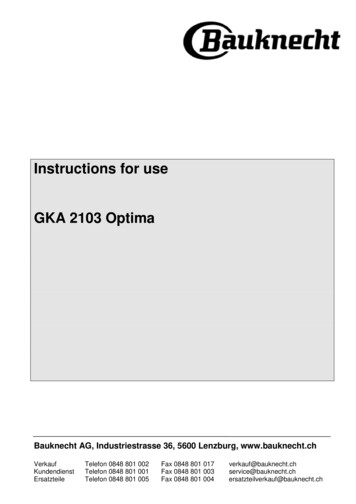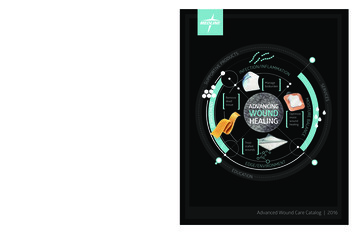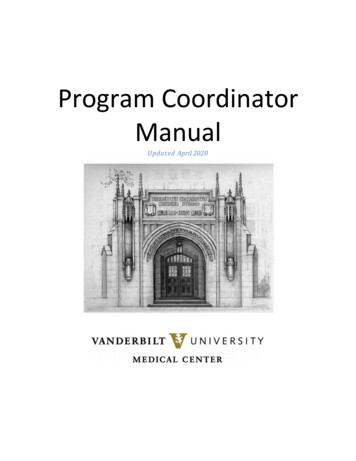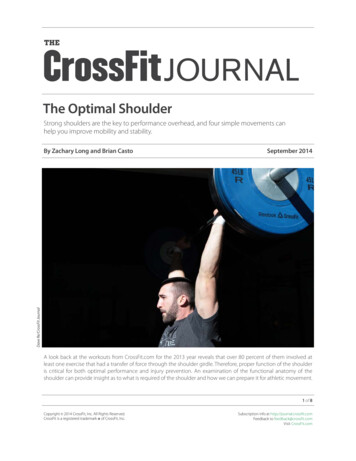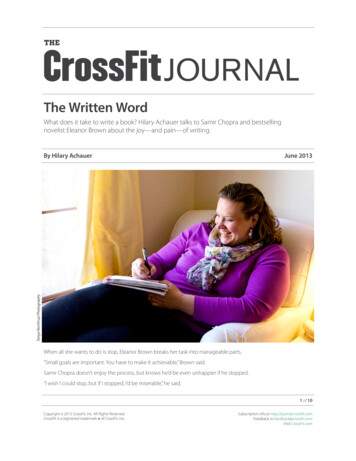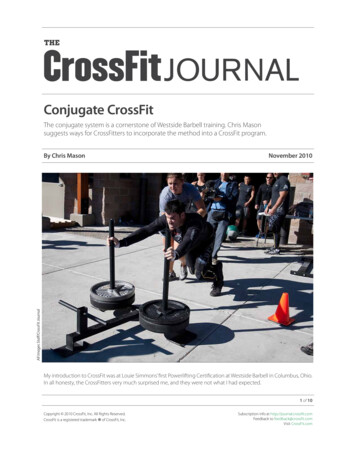
Transcription
THEJOURNALConjugate CrossFitThe conjugate system is a cornerstone of Westside Barbell training. Chris Masonsuggests ways for CrossFitters to incorporate the method into a CrossFit program.November 2010All Images Staff/CrossFit JournalBy Chris MasonMy introduction to CrossFit was at Louie Simmons’ first Powerlifting Certification at Westside Barbell in Columbus, Ohio.In all honesty, the CrossFitters very much surprised me, and they were not what I had expected.1 of 10Copyright 2010 CrossFit, Inc. All Rights Reserved.CrossFit is a registered trademark of CrossFit, Inc. Subscription info at http://journal.crossfit.comFeedback to feedback@crossfit.comVisit CrossFit.com
Conjugate .(continued)My idea of CrossFit prior to getting involved was thatCrossFitters were akin to distance runners; i.e., smallindividuals with great endurance. Suffice it to say thatafter the first cert, my opinion was very much changed.I discovered the true efficacy of the program and whatamazing overall athletes it helped to forge.The Powerlifting Certifications also served to illustrateto me that most CrossFitters, even those at a high levelcompetitively, were in my opinion relatively lacking inabsolute strength. No, I did not think them weak; quiteto the contrary. They were much stronger than I hadanticipated, but compared to their development in otherphysical aspects—such as strength endurance, endurance,flexibility and mobility—their absolute strength wasrelatively poor.It is an immutable fact that an increase in absolutestrength for any CrossFitter would make him or her a betterCrossFitter assuming said strength is not accompanied bya big increase in total body weight (or a detraining effecton endurance or strength endurance). Simmons’ Westsidesystem of strength training is for my money the mosteffective strength-building system ever developed.That said, CrossFit is its own modality with specific goals:“Our specialty is not specializing. Combat, survival, manysports, and life reward this kind of fitness and, on average,punish the specialist.” It is not realistic to expect a CrossFitpractitioner to adopt the Westside system wholly andfully because he or she would, by definition, no longerbe a CrossFitter. So, the question is how to incorporatesome of Louie’s principles into a CrossFit-based program,and it is a question I’ve carefully considered since thatfirst certification.CrossFitters such as Dave Lipson (squatting) are very strong, but Chris Mason believes all CrossFitterscould benefit from more strength if it doesn’t decrease performance in any other areas.2 of 10Copyright 2010 CrossFit, Inc. All Rights Reserved.CrossFit is a registered trademark of CrossFit, Inc. Subscription info at http://journal.crossfit.comFeedback to feedback@crossfit.comVisit CrossFit.com
Conjugate .(continued)Strength certainly came in handy in the 2009 CrossFit Games, where competitorswere faced with a series of heavy deadlifts in the second event.To be clear, the ideas presented in this article are thereforenot Westside ideas. Westside is a unique system developedby Louie Simmons, and it is a system he does not believe inaltering or bastardizing in any way. The training methodsand techniques presented here are therefore snippets ofthe total Westside system, from which I am borrowing inorder to help CrossFit practitioners continue to build theirCrossFit abilities while simultaneously increasing theirabsolute strength. The ultimate goal, of course, is improvedCrossFit performance.Conjugate System and Max-Effort WorkOne of the cornerstones of Westside is the conjugatesystem. Those who know of the conjugate system mostcommonly understand it to be a method that utilizes afrequent rotation of exercises or variations of said exercises(changing the bar, stance, hand placement and range ofmotion; using varying accommodating resistance devices;and so on) in order to preclude neural overtraining andwork on weaknesses. They are correct, but that is only partof the story.The conjugate system also creates a chaotic form ofperiodization. The periodization is one of volume. The useof different exercises to work the same body parts forcesa variation in total training volume primarily by virtue ofthe fact that different exercises dictate different trainingloads. What one can back squat is very different from whatone can front squat, and so on. Therefore, performing bothmovements for a similar number of sets will result in avaried amount of total training volume.Another Westside staple is the maximum-effort (ME) day.ME training involves a progressive warm-up to a maximumsingle attempt (1RM). ME work combined with conjugatevariety is, in my opinion, what makes the Westside systemunrivaled in its ability to build absolute strength. It allowsWestside practitioners to train at a 100 percent intensitylevel virtually year round. No other system allows for thisfrequency of heavy training, and if all other factors areequal, the individual who trains heavy the most often willdevelop the most strength.3 of 10Copyright 2010 CrossFit, Inc. All Rights Reserved.CrossFit is a registered trademark of CrossFit, Inc. Subscription info at http://journal.crossfit.comFeedback to feedback@crossfit.comVisit CrossFit.com
Conjugate .(continued)OvertrainingI have seen other articles and posts online where individualshave attempted to incorporate the entire Westsideprotocol into a CrossFit regimen. This, in my opinion, is amistake. Both training disciplines are extremely physicallyand mentally taxing. An attempt to do both in entirety is asurefire recipe for overtraining.Overtraining of the nervous and skeletal muscular systemsis highly correlated to both training intensity (defined asa percentage of one’s 1RM) and total training volume.Increased training intensity requires decreased volumelest neural overtraining occur. High-volume training, evenat a low-to-moderate intensity level, can lead to skeletalmuscular overtraining in relatively short order. MuchCrossFit training (met-con) falls into the low- to moderateintensity range, while a significant percentage of Westsidetraining is of a very high-intensity variety. The combinationof both programs in their entirety would therefore quicklylead to stagnation at best, and both neural and muscularovertraining and subsequent regression in developmentat worst.expression beyond those benefits. This line of thinkingcombined with the need for economy of total trainingvolume was the main reason I decided not to incorporateDE days into my hybrid system.Additionally, it was, and still is, my feeling that most CrossFitmet-cons can serve a very similar function to DE days inthe way they support ME strength training with the addedbenefit of building one’s general conditioning.Exclusion of Dynamic-Effort WorkThose familiar with Westside have likely also heard the term“dynamic effort” (DE). This facet of the Westside programis also known as “speed work.” DE days use relativelylight loads (typically 50-60 percent intensity) moved for2-3 repetitions as quickly as possible. The primary goalof DE training is to teach the nervous system how to bemore explosive.As per Simmons, the advent of the DE day was due to theinability of most trainees to tolerate two ME days (twoupper and two lower) per week. The DE days were thusinitially incorporated as a less-intense training session or,to say it another way, as a type of active recovery. WhileDE days are less intense, Simmons still considers themto directly aid strength training via their ability to buildexplosive power, which he feels translates directly to1RM lifts.This point is where my opinion definitely varies from Louie’s(at least with respect to my understanding of his stance onthe matter). I feel the primary value of DE days for strengthtrainees is the aforementioned active recovery that aidsboth the muscular and nervous systems. I believe thespeed work translates very minimally to absolute strengthChris Mason’s system has athletes lifting heavy andforgoing dynamic work in favor of CrossFit met-cons.4 of 10Copyright 2010 CrossFit, Inc. All Rights Reserved.CrossFit is a registered trademark of CrossFit, Inc. Subscription info at http://journal.crossfit.comFeedback to feedback@crossfit.comVisit CrossFit.com
Conjugate .(continued)The SystemOK, so we are finally to the system. How does that principlego? Keep it simple, stupid? The basic template of my hybridsystem is indeed very simple. Two ME days (one upperand one lower) are performed each week. They are to beseparated by 72 hours. Three additional days per weekare set aside for more or less standard CrossFit met-cons.The only caveat on the met-cons is this: those that involvelower repetitions or heavier loads are avoided duringthe program.The ME days include assistance work. This assistancework incorporates isolation exercises. While isolationmovements are normally eschewed in the CrossFitworld, they are absolutely necessary for optimizingmaximal strength. This is due to a couple of factors. First,the very nature of compound movements, the physicsinvolved, and the individual’s anatomy and physiologydictate that for every athlete, certain muscles will be thelimiting factor(s) for demonstrable strength. For example,your unique anatomy and physiology may be such thatyour triceps are the limiting factor when you attempt a1RM press. Without specific triceps work, you will neverrealize your true pressing potential. Along similar lines,isolation exercises also allow for a greater overload of thetargeted muscle(s).The primary exercise for upper or lower ME sessions will berotated every fourth week. This is another major variancefrom the standard Westside system. The reasoningbehind this change is simply one of adaptation to thetarget audience. No CrossFitter alive has developed hisor her strength to such a level that weekly variation ofME exercises is required. In fact, weekly rotations wouldbe excessive in my opinion and would not allow for theneural adaptations of increased efficiency at recruitingmotor units and optimizing firing sequences. Theseadaptations result in the ability to place greater stress onthe skeletal muscular system, thus making a given exercisemore effective.In Mason’s system, two days involve maximum effort on heavy lifts, while three daysare set aside for met-con work and more traditional CrossFit workouts.5 of 10Copyright 2010 CrossFit, Inc. All Rights Reserved.CrossFit is a registered trademark of CrossFit, Inc. Subscription info at http://journal.crossfit.comFeedback to feedback@crossfit.comVisit CrossFit.com
Conjugate .(continued)Mikko Salo has an impressive combination of strength, power and endurance.Conjugate training might be one way for CrossFitters to move their numbers to Salo’s level.That said, after three weeks the possibility of overtrainingfrom performing the same movement at 100 percentintensity becomes very real, even for less-developedathletes (in terms of absolute strength), and thus theswitch on the fourth week.Assistance exercises will be varied, but not in the sameregimented fashion due to the fact they are performedat much lower intensity levels (repetition ranges from8-20 plus).Below you will find a specific nine-week exercise templatefor the ME days. This is supplied for those who will notcreate their own program. There is also a listing of severalexercises from which to choose for both primary andassistance work, and I encourage everyone reading thisarticle to take the basic template and use the exercise listto create a unique program. This will allow you to addressyour individual weaknesses. Only then will you reap the fullbenefits of the template.This article will not discuss the CrossFit met-con daysbeyond the aforementioned caveat that they do notinclude heavy, low-repetition movements. And a wordof caution: keep the total volume reasonable. In otherwords, choose your WODs carefully and train them withgreat intensity of effort, but do not do work above andbeyond them.ExercisesThe exercises listed below are those that can be performedat most CrossFit boxes (with the possible exception ofthose done with dumbbells; kettlebells can be substitutedin some cases).6 of 10Copyright 2010 CrossFit, Inc. All Rights Reserved.CrossFit is a registered trademark of CrossFit, Inc. Subscription info at http://journal.crossfit.comFeedback to feedback@crossfit.comVisit CrossFit.com
Conjugate .(continued)LowerFree squatBox squatFront squatGood morningDeadlift from floorRack deadliftDeficit deadliftZercher deadliftAll the above exercises have multiple variations via the useof different bars, hand placements, and rack positions (asin performing partials), as well as the addition of bandsand/or chains. More variations exist if you can make substitutions with dumbbells. The number of variations is reallyonly limited by the imagination of the trainee.Assistance ExercisesAssistance work sets should be taken to or very near toconcentric failure (perhaps 1-2 reps short).UpperDumbbell pressWeighted dipJM pressMaxing out on a wide variety of squats is oneof the keys of conjugate training.Tate pressSkullcrusherTriceps pressdown (with machine or band)Primary ExercisesUpperDumbbell triceps rollbackStanding strict pressBent-over row (elbows held in line with shoulders andbarbell pulled very high on chest)Push pressDumbbell rowBench pressBarbell T-bar rowIncline pressFace pullsFloor pressUpright rowBoard pressPress from pins7 of 10Copyright 2010 CrossFit, Inc. All Rights Reserved.CrossFit is a registered trademark of CrossFit, Inc. Subscription info at http://journal.crossfit.comFeedback to feedback@crossfit.comVisit CrossFit.com
Conjugate .(continued)LowerTemplate Routine With ExercisesGlute-ham raiseThe sets listed below for assistance work are workingsets. These sets may be preceded by 2-3 warm-up setsif required.Glute bridgeHamstring curl (with bands)HyperextensionUpper (Weeks 1-3)Standing strict press (ME exercise)Stiff-legged deadliftSeated dumbbell press: 2 x 15 repsStanding hyper with band over neckJM press: 2 x 10Sled workTriceps pressdown (you can use a band for these; choke itup enough to make 10 reps very hard): 2 x 10Reverse hyperI will leave ab exercises to the discretion of the trainee.There are a myriad of them. Pick one per ME session.Barbell row (row to nipple level, keeping elbows perpendicular to your body; this will work the upper back veryeffectively): 2 x 10Ab work of your choice: 2 x 15-20 repsBy rotating lower-body exercises, you can avoid overtraining. A front squattaxes the nervous system very differently than a back squat.8 of 10Copyright 2010 CrossFit, Inc. All Rights Reserved.CrossFit is a registered trademark of CrossFit, Inc. Subscription info at http://journal.crossfit.comFeedback to feedback@crossfit.comVisit CrossFit.com
Conjugate .(continued)Lower (Weeks 1-3)Lower (Weeks 7-10)Squat (ME exercise)Squat (with strong bands) (ME exercise)Glute-ham raise: 2 x as many as possibleOlympic squat (narrow stance as deep as possible; be sureto control the movement all the way up and down): 1 x 15Glute bridge (off bench): 1 x 20Ab work of your choice: 2 x 15-20Heavy sled pull: 3 rounds of pulling for roughly 100 feet(allow 1 minute between rounds; be sure the sled weightis heavy but not ridiculously so; try to increase the load 10lb. per session)Reverse hyper: 3 x 10Ab work of your choice: 2 x 15-20Upper (Weeks 4-6)Incline bench press (ME exercise)Flat dumbbell press: 2 x 15Dumbbell Tate press: 2 x 10Dumbbell rollback: 2 x 10Single-arm dumbbell row: 2 x 10Ab work of your choice: 2 x 15-20Lower (Weeks 4-6)Box squat (with strong bands) (ME exercise)Deficit deadlifts (off a 4-inch or so box): work up to a heavyset of 5Ab work of choice: 2 x 15-20Heavy sled work (same as above)Upper (Weeks 7-10)Bench press (ME exercise)Incline dumbbell press: 2 x 15Close-grip bench press (hands just outside the smoothportion of the bar): 2 x 10Triceps pressdown: 2 x 10Curl-grip barbell row: 2 x 10Ab work of your choice: 2 x 15-20The conjugate system is designed to systematicallyeliminate the weaknesses that are preventing yournumbers from increasing.9 of 10Copyright 2010 CrossFit, Inc. All Rights Reserved.CrossFit is a registered trademark of CrossFit, Inc. Subscription info at http://journal.crossfit.comFeedback to feedback@crossfit.comVisit CrossFit.com
Conjugate .(continued)Go Heavy, Get StrongThis general template and system should be used at leastonce a year by every CrossFitter wanting to get the mostout of his or her training. Absolute strength is a componentof fitness that should not be relegated to also-ran status inanyone’s overall fitness regimen. It will aid you now, andwith continued work it will help to improve your quality oflife even into your later years. Give this program a go—youwon’t regret it.If you have any questions please feel free to ask them inthe comments sections of the Journal or on the CrossFitMessage Board.FAbout the AuthorChris Mason is the co-owner of AtLarge Nutrition. Chris hasbeen involved with bodybuilding and powerlifting for overtwo decades. He is an accomplished writer in the genre,having published articles in Athlete, Planet Muscle,Ironman and Powerlifting USA magazines, as well asonline. You can view several of his articles on his websiteWannaBeBig.com. Chris currently resides in Charlottesville, Va.,and makes monthly treks to Ohio to train at Westside Barbell withLouie Simmons. He is also a member of Louie’s team for CrossFitPowerlifting Certs.10 of 10Copyright 2010 CrossFit, Inc. All Rights Reserved.CrossFit is a registered trademark of CrossFit, Inc. Subscription info at http://journal.crossfit.comFeedback to feedback@crossfit.comVisit CrossFit.com
The conjugate system is a cornerstone of Westside Barbell training. Chris Mason suggests ways for CrossFitters to incorporate the method into a CrossFit program. All Images Staff/CrossFit Journal My introduction to CrossFit was at Louie Simmons’ first Powerlifting Certificatio

